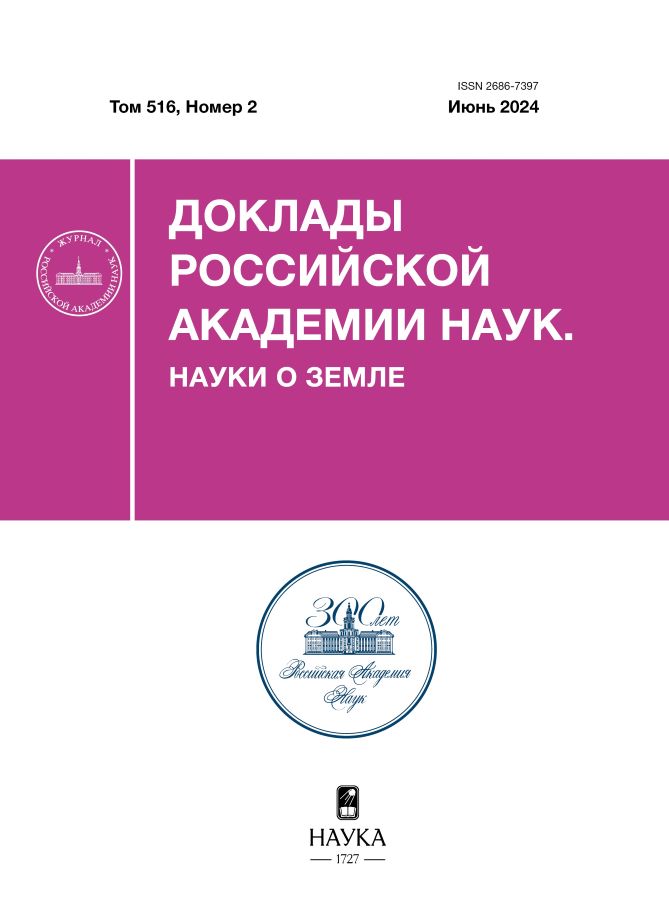Sources of Neogene rare metal-titanium placers of the northeastern side of the Dnieper-Donetsk Basin: first results of U–Pb geochronological studies of detrital zircon
- Authors: Chefranova A.V.1, Erofeeva K.G.1,2, Dubenskiy A.S.2
-
Affiliations:
- Institute of Geology of Ore Deposits, Petrography, Mineralogy, and Geochemistry of the Russian Academy of Sciences
- Geological Institute of the Russian Academy of Sciences
- Issue: Vol 516, No 2 (2024)
- Pages: 576-581
- Section: MINERALOGY
- Submitted: 31.01.2025
- Published: 12.12.2024
- URL: https://edgccjournal.org/2686-7397/article/view/650045
- DOI: https://doi.org/10.31857/S2686739724060094
- ID: 650045
Cite item
Abstract
The sources of terrigenous material involved in the structure of Neogene rare metal-titanium placers on the northeastern side of the Dnieper-Donetsk Basin (DDB) were determined using lithological and mineralogical methods was used, including U-Pb geochronological and chemical study of detrital zircon. Characteristics of the accessory mineral association of the placer, the morphology of individual mineral grains, and the depletion of U, Th, Y, Yb in most of the zircon population indicate that the source was chemical residue probably formed on Proterozoic (70%) and Neoarchean (15%) metamorphic rocks. The presence of zircon crystals with Paleozoic U-Pb age and high contents of U, Th, Y and Yb indicates the proximal source destruction of igneous rocks of Neoproterozoic-Early Paleozoic trap formations, Devonian igneous and volcanic-sedimentary rocks of the DDB. Perhaps the development of salt tectonics, which is widespread in the DDB, facilitated the involvement of debris from the above rocks in sedimentary recycling.
Full Text
About the authors
A. V. Chefranova
Institute of Geology of Ore Deposits, Petrography, Mineralogy, and Geochemistry of the Russian Academy of Sciences
Author for correspondence.
Email: achefra@mail.ru
Russian Federation, Moscow
K. G. Erofeeva
Institute of Geology of Ore Deposits, Petrography, Mineralogy, and Geochemistry of the Russian Academy of Sciences; Geological Institute of the Russian Academy of Sciences
Email: achefra@mail.ru
Russian Federation, Moscow; Moscow
A. S. Dubenskiy
Geological Institute of the Russian Academy of Sciences
Email: achefra@mail.ru
Russian Federation, Moscow
References
- Александрова Г. Н., Ерофеева К. Г., Кузнецов Б. Н., Романюк Т. В., Шешуков В. С., Дубенский А. С., Ляпунов С. М., Яковлева А. И., Паньков В. Н. Первые результаты U-Pb датирования зерен детритового циркона из олигоцена юго-востока Воронежской антеклизы и их значение для палеогеографии // Доклады Российской академии наук. Науки о Земле. 2020. Т. 494. № 1. С. 14–19.
- Аранович Л. Я., Бортников Н. С., Зингер Т. Ф., Борисовский С. Е., Матреничев В. А., Перцев А. Н., Шарков Е. Ф., Сколотнев С. Г. Морфология и элементы-примеси циркона из океанической литосферы осевой зоны Срединно-Атлантического хребта (6°–13° с. ш.): свидетельства особенностей магматической кристаллизации и постмагматических преобразований // Петрология. 2017. Т. 25. № 4. С. 1–28.
- Ганжа Е. А. Лаломов А. В., Чефранова А. В., Григорьева А. В., Магазина Л. О. Структурно-литологическая геолого-генетическая модель и минеральный состав Краснокутского редкометалльно-титанового россыпного месторождения (Украина) // Литология и полезные ископаемые. 2019. № 6. С. 540–556.
- Лукин А. Е., Цеха О. Г., Гейко Т. С., Омельченко В. В. Тектоника северного борта Днепровско-Донецкого авлакогена в контексте общих закономерностей континентального рифтогенеза // Геологический журнал. 2012. № 3. С. 7–38.
- Панов Ю. Б., Чернышов О. Г. Особенности изотопного состава цирконов россыпных титан-циркониевых месторождений Украины // Геолого-мiнералогiчний вiсник. 2008. №1(19). С. 45–55.
- Холодов В. Н. Элизионные системы Днепрово-Донецкого авлакогена. Сообщение 2. Катагенетические процессы Днепрово-Донецкой и Припятской впадины и некоторые металлогенические особенности авлакогена // Литология и полезные ископаемые. 2012. № 1. С. 53–77.
- Цымбал С. Н., Полканов Ю. А. Минералогия титано-циркониевых россыпей Украины. Киев: Наукова думка, 1975. 248 с.
- Чефранова А. В., Чефранов Р. М. Минералы-индикаторы питающих провинций редкометалльно-титановых россыпей Ставропольского свода: Циркон // Геология рудных месторождений. 2022. Т. 64. № 5. С. 574–594
- Щербаков И. Б. Петрология Украинского щита. Львов: ЗУКЦ, 2005. 366 с.
- Belousova E. A., Griffin W. L. et al. Igneous zircon: trace element composition as an indicator of source rock type // Contrib. Mineral. Petrol. 2002. V. 143. P. 602–622
- Bogdanova S. V., Gorbatschev R., Garetsky R. G. EUROPE East European Craton // Reference Module in Earth Systems and Environmental Sciences. Elsevier: Amsterdam, 2016. P. 1–18
- Griffin W. L., Powell W. J., Pearson N. J., O’Reilly S. Y. GLITTER: Data Reduction Software for Laser Ablation ICP-MS // Laser Ablation ICP-MS in the Earth Sciences: Current Practices and Outstanding Issues (ed. P.J. Sylvester). Mineralogical Association of Canada short course series 40. 2008. P. 308–311. 13.
- Guynn J., Gehrels G. Comparison of Detrital Zircon Age Distribution Using the K-S Test Visualization and Representation of Age-Distribution Data Histograms. 2010. URL: https://sites.google.com/laserchron.org/arizonalaserchroncenter/home (date of application: January 18, 2023)
- Shumlyanskyy L., Tsymbal S., Monika A. Kusiak M.A., Wilde S.A., Alexander A. Nemchin A.A., Tarasko I., Shumlianska L., Hofmann M. U-Pb Age and Hf Isotope Systematics of Zircon from Eclogite Xenoliths in Devonian Kimberlites: Preliminary Data on the Archaean Roots in the Junction Zone between the Sarmatian and Fennoscandian Segments of the East European Platform // Geosciences. 2021. 11. P. 487.
Supplementary files












